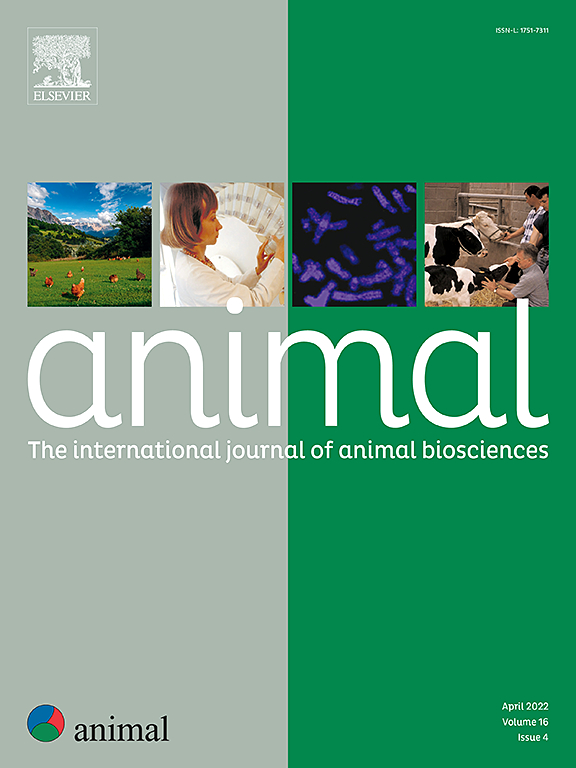荷斯坦、弗里西亚和西蒙塔尔奶牛泌乳早期能量需求的代谢适应
IF 4.2
2区 农林科学
Q1 AGRICULTURE, DAIRY & ANIMAL SCIENCE
引用次数: 0
摘要
荷斯坦弗里马(HF)是世界上性能最高的奶牛品种。然而,由于代谢不稳定,这个品种容易患上健康失调和不育。本研究的目的是利用德国HF和德国西门塔尔(SI)的代谢差异,探讨已知途径和新途径的生物学影响及其各自的指标。因此,使用靶向代谢组学方法结合血浆样本的经典临床化学检查来描述预期产犊前42天和哺乳第21天的代谢状况。共选取27头产牛(HF n = 17, SI n = 10)进行试验。所有奶牛被饲养在同一个农场,在相同的管理、喂养和饲养条件下。泌乳前几周,HF奶牛的体重下降,SI奶牛的体重保持不变,但产奶量低于HF奶牛。检测到以下指标和相关途径的差异,并用于评估其生物影响。HF奶牛的支链氨基酸如亮氨酸和异亮氨酸在+21天仍与−42天一样高;然而,在SI奶牛中,观察到这些氨基酸明显下降,表明该品种体内蛋白质动员较少。α -氨基己二酸和犬尿氨酸作为氧化应激平衡的标志物在第21天增加,仅反映HF奶牛代谢更紧张的状态。综上所述,这些发现证实了这些代谢物对患代谢性疾病的高风险的影响。本文章由计算机程序翻译,如有差异,请以英文原文为准。
Metabolic adaptation to energetic demands of early lactation in Holstein Friesian and Simmental cows
Holstein Friesian (HF) is the highest-performing dairy breed worldwide. However, this breed is prone to suffer from health disorders and infertility due to metabolic instability. The aim of the study was to use the metabolic differences between to breed, German HF and German Simmental (SI), for discussion of the biological impact of well-known and novel pathways and their respective indicators. Therefore, a targeted metabolomics approach combined with an examination of classical clinical chemistry using plasma samples was used to describe the metabolic status 42 days before expected calving and at day 21 of lactation. In total, 27 multiparous cows (HF n = 17, SI n = 10) were enrolled in the study. All cows were kept on the same farm under identical management, feeding and housing conditions. BW of HF cows dropped while SI cows maintained their BW but produced less milk than HF cows during the first weeks of lactation. Differences were detected for the following indicators and related pathways, and were used to assess their biological impact. Branched-chain amino acids such as leucine and isoleucine at day +21 remained as high as at day −42 in HF cows; however, in SI cows, a clear drop in these amino acids was observed indicating less body protein mobilisation in this breed. Alpha amino-adipic acid and kynurenine as markers for oxidative stress balance were increased at day +21 in HF cows, only reflecting a metabolically more tensed condition in HF cows. As a conclusion, these findings confirm the impact of these metabolites on a higher risk to suffer from metabolic disorders.
求助全文
通过发布文献求助,成功后即可免费获取论文全文。
去求助
来源期刊

Animal
农林科学-奶制品与动物科学
CiteScore
7.50
自引率
2.80%
发文量
246
审稿时长
3 months
期刊介绍:
Editorial board
animal attracts the best research in animal biology and animal systems from across the spectrum of the agricultural, biomedical, and environmental sciences. It is the central element in an exciting collaboration between the British Society of Animal Science (BSAS), Institut National de la Recherche Agronomique (INRA) and the European Federation of Animal Science (EAAP) and represents a merging of three scientific journals: Animal Science; Animal Research; Reproduction, Nutrition, Development. animal publishes original cutting-edge research, ''hot'' topics and horizon-scanning reviews on animal-related aspects of the life sciences at the molecular, cellular, organ, whole animal and production system levels. The main subject areas include: breeding and genetics; nutrition; physiology and functional biology of systems; behaviour, health and welfare; farming systems, environmental impact and climate change; product quality, human health and well-being. Animal models and papers dealing with the integration of research between these topics and their impact on the environment and people are particularly welcome.
 求助内容:
求助内容: 应助结果提醒方式:
应助结果提醒方式:


